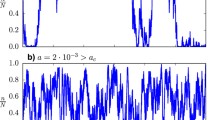Abstract
We compare the two-dimensional voter model with approximate theories for spinodal decomposition. The cluster size distribution and the short-time dynamics of the voter model are studied by means of a Monte Carlo simulation. The time-dependent structure factor and the long-time scaling of the voter dynamics are known analytically.
Similar content being viewed by others
References
S. W. Koch, R. C. Desai, and F. F. Abraham,Phys. Rev. Lett. 49:923 (1982);Phys. Rev. A 27:2152 (1983).
T. M. Liggett,Interacting Particle Systems (Springer, Berlin, 1985), and references therein to previous work.
J. T. Cox and D. Griffeath,Ann. Prob. 14:347 (1986).
F. F. Abraham,Phys. Rev. C 53:93 (1979).
K. Binder, inNonlinear Systems in Physics, Chemistry and Biology, L. Arnold and R. Lefever, eds. (Springer, Berlin, 1981).
J. D. Gunton, M. San Miguel, and P. S. Sahni, inPhase Transitions and Critical Phenomena, Vol. 8, C. Domb and J. L. Lebowitz, eds. (Academic Press, London, 1984).
J. L. Lebowitz, J. Marro, and M. H. Kalos,Commun. Solid. State Phys. 10:201 (1983).
N. van Kampen,J. Stat. Phys. 17:71 (1977).
R. Glauber,J. Math. Phys. 4:294 (1963).
M. Bramson and D. Griffeath,Ann. Prob. 7:418 (1973).
P. Major,Studia Sci. Math. Hung. 15:321 (1980).
E. Presutti and H. Spohn,Ann. Prob. 11:867 (1983).
F. Spitzer,Principles of Random Walk, 2nd ed. (Springer, Berlin, 1976).
P. Fratzl, J. L. Lebowitz, J. Marro, and M. H. Kalos,Acta Metall. 31:1849 (1983).
J. Marro, J. L. Lebowitz, and M. H. Kalos,Phys. Rev. Lett. 43:282 (1979).
K. Binder and C. Billotet,Z. Phys. B 32:495 (1979).
J. S. Langer, M. Bar'on, and H. D. Miller,Phys. Rev. A 11:1417 (1975).
M. Kimura,Proc. Natl. Acad. Sci. Genet. 1954:144 (1954).
S. Tavare,Theor. Popul. Biol. 26:119 (1984).
P. M. Morse and H. Feshbach,Methods of Theoretical Physics (McGraw-Hill, New York, 1953), p. 782.
D. Stauffer,Introduction to Percolation Theory (Taylor and Francis, 1985).
D. Heermann,Z. Physik B 55:309 (1984).
R. C. Desai and A. Denton, inOn Growth and Form, N. Ostrowsky and H. E. Stanley, eds. (Nijhoff, 1986).
Author information
Authors and Affiliations
Additional information
This paper is dedicated to Nico van Kampen on the occasion of his 67th birthday.
Rights and permissions
About this article
Cite this article
Scheucher, M., Spohn, H. A soluble kinetic model for spinodal decomposition. J Stat Phys 53, 279–294 (1988). https://doi.org/10.1007/BF01011557
Received:
Issue Date:
DOI: https://doi.org/10.1007/BF01011557




